Arthur Byron Newman, 1863 - 1940
by Brian Stevenson
last updated May, 2023
A.B. Newman was a businessman in Fairport, New York, who developed a strong interest in microscopy during the last quarter of the nineteenth century (Figures 1-4). He was especially well-known for his microscope slides of diatoms (Figure 3).
In 1895, Newman was described as having, “made a study for many years of the microscope and has a collection of over one thousand mounted slides, a good microscopical library, and is a member of the Royal Microscopical Society of England and the American Society of Microscopists.”
Newman was acquainted with Ezra H. Griffith (1839-1894), who also lived in Fairport and is best known for inventing the “Griffith Club” microscope. When Griffith moved to Chicago ca. 1891, Newman acted as Griffith’s representative for sales of microscopes and lenses (Figure 5).
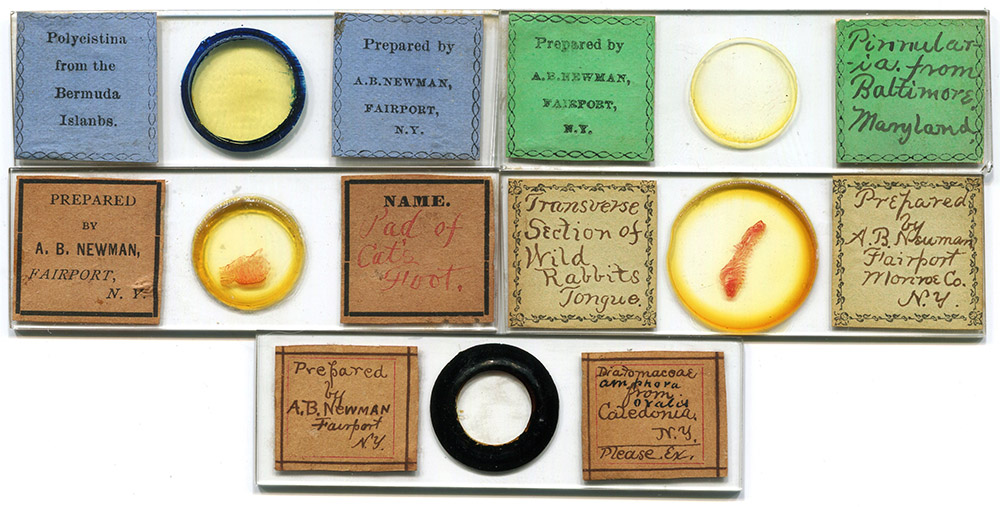
Figure 1.
Microscope slides that were prepared by A.B. Newman, probably ca. 1880s-1890s. Despite the typeset labels, Newman is not known to have been a professional slide-maker, but prepared these slides for his own use or for exchange with colleagues. The two slides that have labels with Newman’s handwritten name and address were presumably made during his earliest days, ca. 1880.
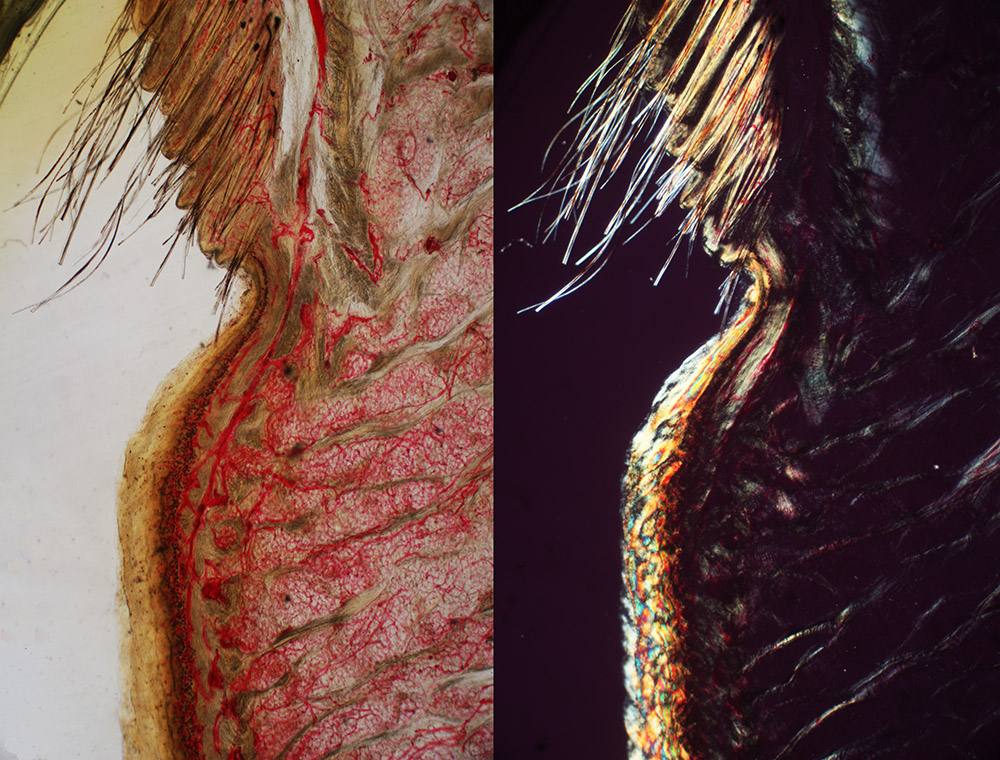
Figure 2.
“Pad of cat foot”, prepared by A.B. Newman, ca. 1880-90 (See Figure 1). He presumably stained and sections the specimen. Imaged with a C-mounted digital SLR camera and 3.5x objective lens on a Leitz Ortholux II microscope, with (left) brightfield and (right) crossed polarizing filters.
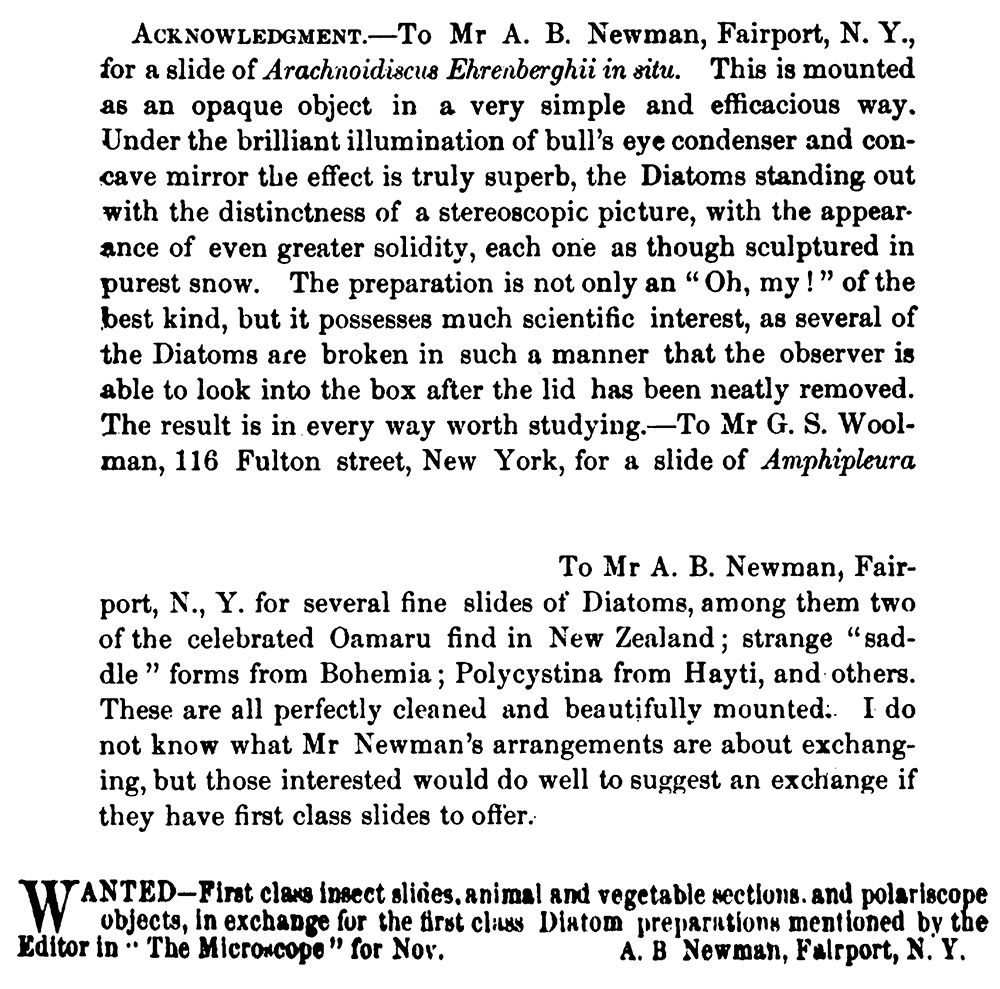
Figure 3.
In 1890, A.B. Newman sent examples of his slides to “The Microscope” magazine. The editors were evidently impressed with his mounts, and wrote enthusiastic recommendations to readers to “to suggest an exchange if they have first class slides to offer”. Newman also published exchange offers that year in the magazine, referring to the praise he received.

Figure 4.
An 1892 exchange offer from “The Microscope”, where Newman was seeking to exchange microscope components and “slides of diatoms in exchange for general mounts”.
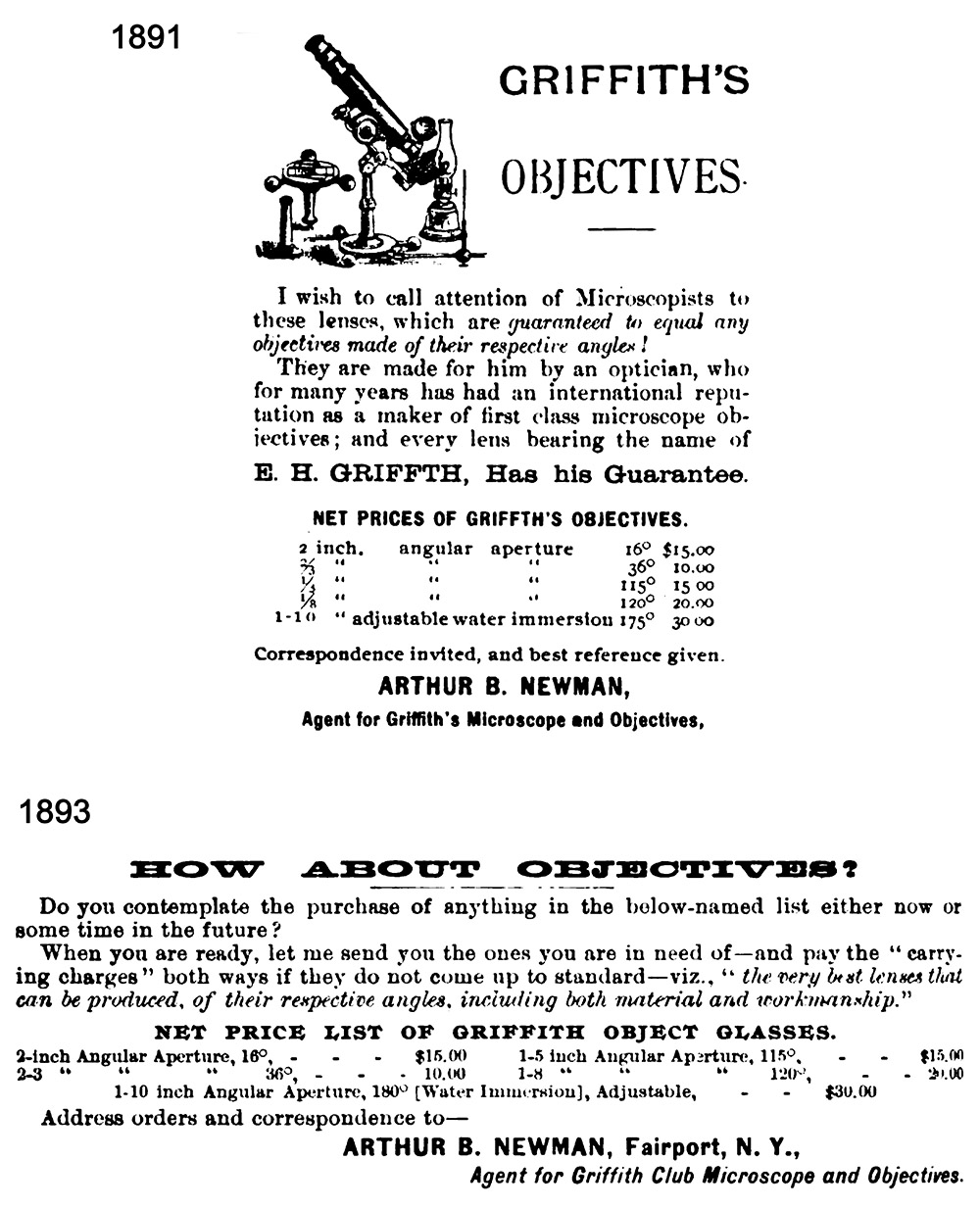
Figure 5.
Ezra Hollis Griffith (1839-1894) invented his “Griffith Club” microscope ca. 1880. In about 1891, he moved from Fairport to Chicago, and enlisted his colleague A.B. Newman to serve as a distributor for the microscope and Griffith’s custom-made lenses. From “The Microscope”, 1891 (top), and “The American Monthly Microscopical Journal”, 1893 (bottom).
The early life of Arthur B. Newman was summarized in the 1895 Landmarks of Monroe Count, New York:
“Newman, Arthur B., town clerk of Perinton, was born in the village of Fairport June 21, 1863, the only son of William M. Newman, the well known manufacturer. Having graduated from Fairport Union School and spent a year at the University of Rochester, where he was a member of the Delta Psi College fraternity; he entered in 1883 the sophomore class at Cornell, designing to follow architecture, in which he had already received practical training in the office of Walker & Nolan of Rochester, but owing to impaired eyesight he was forced to relinquish that career, and in 1888 became associated with his father as a partner, the firm of Newman & Son dating from January 1, 1888.
In 1889 he married Louise, daughter of Jeremiah Gould of Syracuse, and their two sons are Roy M., born July 17, 1890, and Herald G., born April 16, 1894. Mr. Newman's personal popularity is unbounded, and to such men as he preferment comes unsought. A director and treasurer of the local Y.M.C.A., and a trustee of the village, he was also elected in March, 1894, clerk of the town of Perinton. He has also made a study for many years of the microscope and has a collection of over one thousand mounted slides, a good microscopical library, and is a member of the Royal Microscopical Society of England and the American Society of Microscopists. He has also done considerable work in amateur photography and chemistry (as applied to baking powder, soda and other branches connected with his business).”
The life of A.B. Newman’s father was also summarized: “Newman, William M., senior member of the firm of Newman & Son, one of the leading manufacturers of Fairport, was born at Enfield, Tompkins county, September 1, 1826. He is the elder of five sons of the late Nathaniel and Hannah (Davenport) Newman. The family is of English nativity and among the earlier settlers of Pawling, Dutchess county. James, the father of Nathaniel, was a captain in the Revolution. William is the builder of his own fortune. Beyond a single term at the Ithaca Academy, his education was acquired in the common schools of his native town. His business life began at Byron, Genesee county, where he was for five years engaged in mercantile business, coming in 1856 to Fairport as an employee of the late D.B. De Land, in whose employ he remained for twelve years. In 1874 he established the business now operated by Newman & Son, manufacturers and dealers in baking powder, soda and saleratus, spices and extracts, which has grown into one of the important industries of Fairport. Mr. Newman is a citizen of character and influence. He has filled many positions of local trust and responsibility, and took an active part in the prohibition movement in Fairport. A prominent member of the Baptist church, he was in 1892 their historian, and prepared an exhaustive and masterly résumé of its temporal and spiritual affairs, dating from 1842. His first wife was Permelia E. Nelson, a daughter of Rev. C. Nelson, who died after twelve years of married life. Her children were Willard D., Ida, and Lena P., the latter alone surviving, and is a teacher in the Deaf and Dumb Institute of Rochester. Mr. Newman married as second wife Mrs. Susan Leonard, a sister of his first wife, and they have had two children, Arthur B. and Mary D., wife of Prof. Carey De W. Brown, of the High School at Erie, Pa.”
A.B. Newman’s middle name may have come from his father having begun to earn his fortune in the city of Byron.
The Newman and Son business manufactured baking powder, which they retailed as “Pure Gold”, and other cooking ingredients (Figure 6). During the 1890s, the firm became the Monroe County Chemical Company.
The 1880 Naturalists’ Directory included an entry for A.B. Newman, noting that he desired to collect and exchange microscopical items. He was then seventeen years old.
By 1890, Newman had become an expert slide-maker. Slides that he sent to the editor of The Microscope received high praise. Newman referred to his products as “first class”, and requested that he receive only “first class” slides in exchange.
Ezra Hollis Griffith (1839-1894) was also in the baking soda business, in Fairport, New York. Around 1880, he developed his portable and multifunctional “Griffith Club” microscope. Griffith contracted production to established microscope manufacturers, such as Bausch and Lomb in nearby Rochester, New York. He also contracted production of objective lenses to his specifications. In 1891, Griffith moved to Chicago, after recruiting A.B. Newman to serve as distributor for the microscope and lenses (Figure 5). This arrangement ended with Griffith’s death in 1894.
Newman was elected as a Fellow of the Royal Microscopical Society in 1892.
His enthusiasm for microscopy appears to have faded by the end of the century. The 1898 edition of The Naturalists’ Directory included a question mark with Newman’s entry, indicating that the Directory’s compilers had not received a response from Newman in some years, and were uncertain about his continued interest in the sciences.
Around 1908, Newman moved to Memphis, Tennessee. The 1910 national census described his occupation as “personal secretary”. The 1920 census listed him as “agent, real estate”.
A.B. Newman died of “coronary thrombosis” on November 12, 1940. At the time, he was a resident of the Berliner Nursing Home, Saint Louis, Missouri.
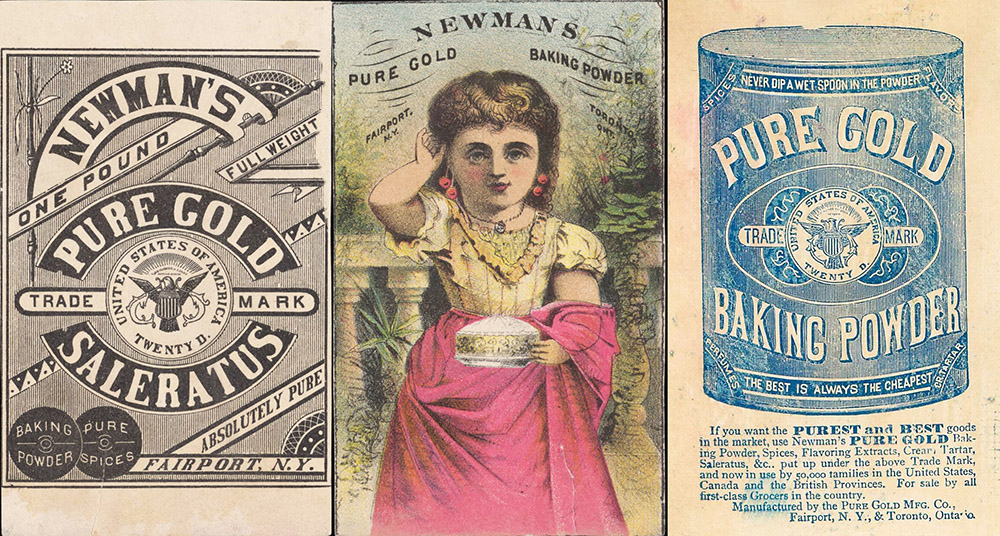
Figure 6.
Cards advertising Newman’s baking powder company, late 1800s. Adapted for educational, nonprofit purposes from internet sale sites.
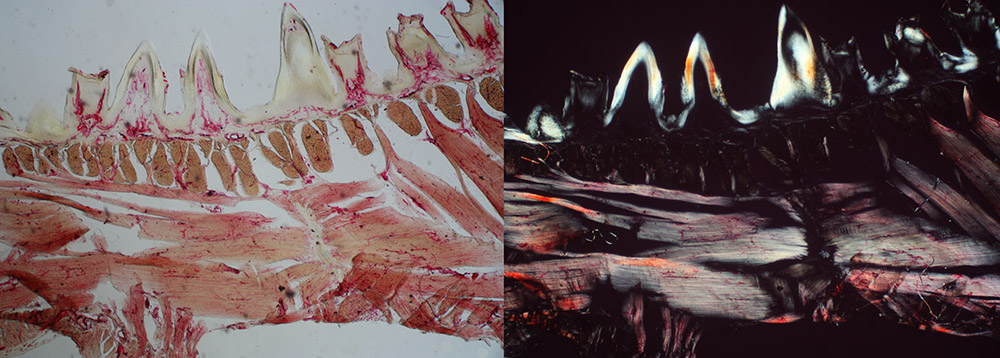
Figure 7.
“Transverse section of wild rabbit’s tongue”, prepared by A.B. Newman, ca. 1880-1890 (See Figure 1). Imaged with a C-mounted digital SLR camera and 3.5x objective lens on a Leitz Ortholux II microscope, with (left) brightfield and (right) crossed polarizing filters.
Resources
The American Monthly Microscopical Journal (1890) “Slides received - We desire to return thanks to the donor for the following interesting slide: Diatomacea: Arachnoidiscus Ehrenbergh from Puget Sound, mounted by Mr. A.B. Newman, Fairport, N.Y.”, Vol. 11, page 275
The American Monthly Microscopical Journal (1893) Advertisement for Griffith’s microscope objectives, Vol. 14, page viii
Cornell Alumni Directory (1922) “Newman, Arthur Byron 88 84-85 Arch Tennessee Trust Bldg Memphis Tenn”, page 236
Death certificate of Arthur B. Newman (1940) accessed through ancestry.com
Griffith, E.H. (1881) The improved Griffith Club microscope, Proceedings of the American Society of Microscopists, pages 149-152
Journal of the Royal Microscopical Society (1880) Griffith Club microscope, pages 293-296
Journal of the Royal Microscopical Society (1892) New fellows, page 445
The Microscope (1890) Editor's acknowledgments of received slides, pages 217 and 343
The Microscope (1891) Advertisement for Griffith’s microscope objectives, unnumbered advertising page
The Naturalists’ Directory (1880) “Newman, Arthur B., Fairport, Monroe Co. Mic. C. Ex.”, Cassino, Boston, page 78
The Naturalists’ Directory (1890) “Newman, Arthur B., Fairport, Monroe Co., N.Y. Diatoms, Mic. C. Ex. Exchange mounted diatoms for any good mounts. First-class work only desired”, Cassino, Boston, page 78
The Naturalists’ Directory (1898) “Newman, Arthur B., Fairport, Monroe Co., N.Y. Diatoms, Mic. C. Ex. ?”, Cassino, Boston, page 139
Newman, A.B. (1890) Exchange offers, The Microscope, multiple issues, unnumbered pages
Newman, A.B. (1892) Exchange offer, The Microscope, unnumbered page
Padgett, Donald L. (1975) A Short History of Early American Microscopes, Microscope Publications, Chicago, pages 116-118
Peck, William Farley (1895) Landmarks of Monroe County, New York, Part 1, Boston History Company, Boston, pages 16-17
Proceedings of the American Microscopical Society (1894) Obituary: Ezra Hollis Griffith, A.M., pages 247-248
Rochester, New York, City Directory (1905) “Monroe County … Newman Arthur B. clerk”, page 739
US census and other records, accessed through ancestry.com






